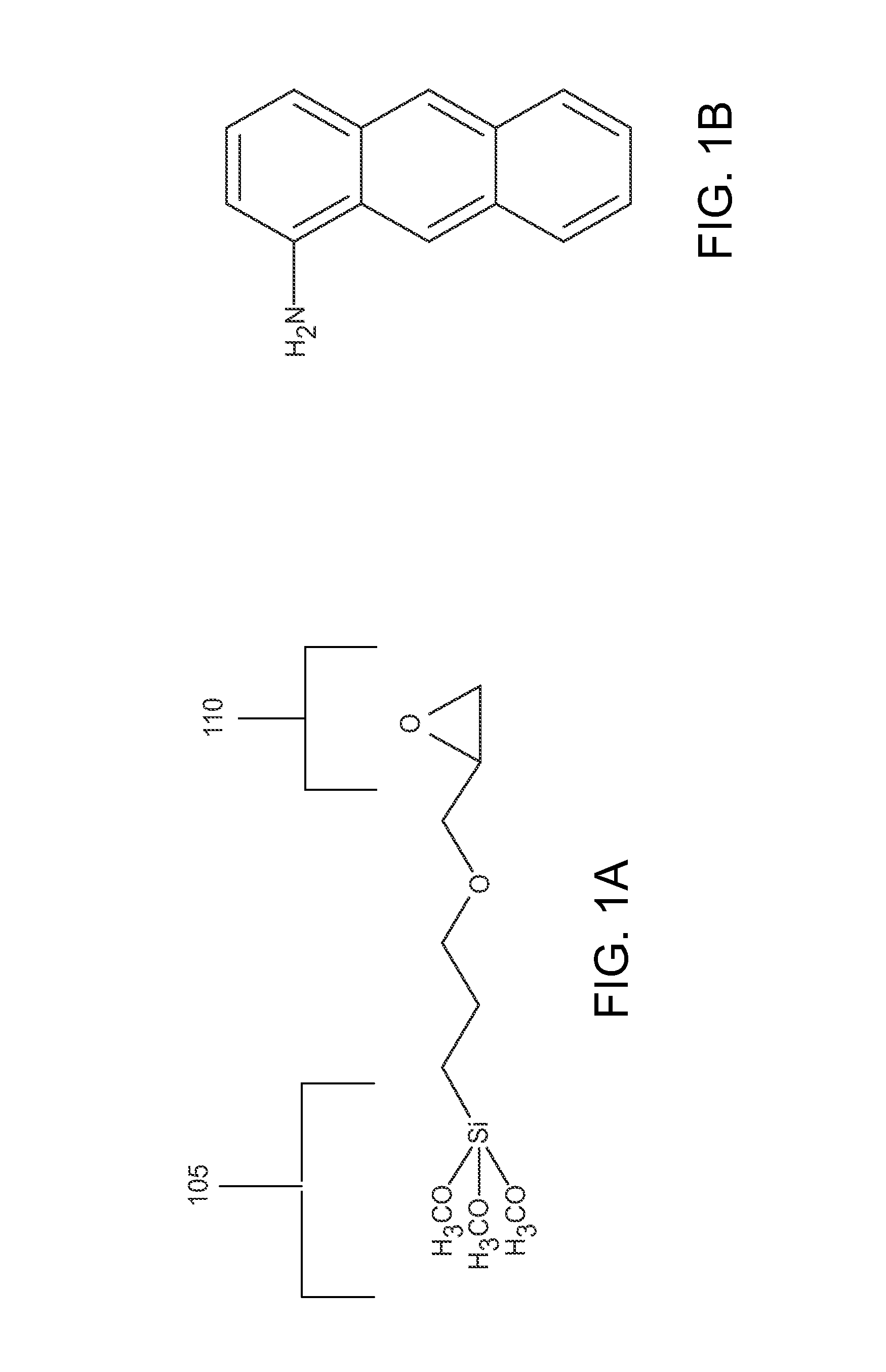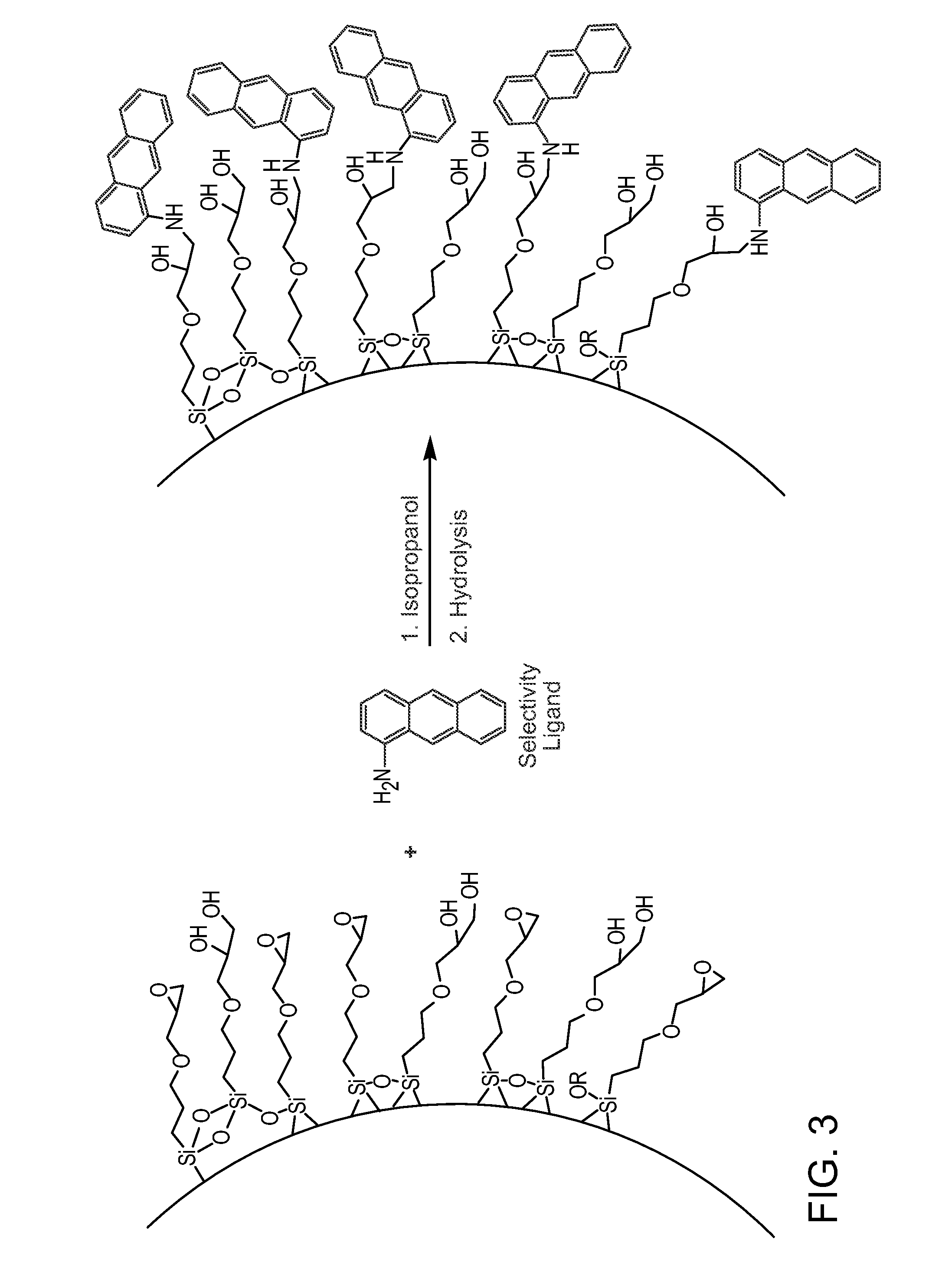Chromatographic materials for the separation of unsaturated molecules
- Summary
- Abstract
- Description
- Claims
- Application Information
AI Technical Summary
Benefits of technology
Problems solved by technology
Method used
Image
Examples
example 1
Preparation of Epoxide Layer for Stationary Phases
[0278]In a typical reaction, hybrid porous particles were dispersed in a solution of glycidoxypropyltrimethoxysilane / methanol (0.25 mL / g) (GLYMO, Aldrich, Milwaukee, Wis.,) in a 20 mM acetate buffer (pH 5.5, prepared using acetic acid and sodium acetate, J.T. Baker. 5 mL / g dilution) that had be premixed at 70° C. for 60 minutes. The mixture was held at 70° C. for 20 hours. The reaction was then cooled and the product was filtered and washed successively with water and methanol (J.T. Baker). The product was then dried at 80° C. under reduced pressure for 16 hours. The specific particles used are shown in Table 1.
TABLE 1Specific Base Particles UtilizedEntryMaterialB1Hybrid Organic Silica (3.8 μm, 90 {acute over (Å)} APD, 1.3 cm3 / g TPV)1B2Hybrid Organic Silica (3.8 μm, 115 {acute over (Å)} APD, 1.3 cm3 / g TPV)1B3Hybrid Organic Silica (2.3 μm, 115 {acute over (Å)} APD, 1.3 cm3 / g TPV)1B4Hybrid Organic Silica (1.7 μm, 143 {acute over (Å)} A...
example 2
Preparation of Stationary Phases with Diol Functionality
[0280]In a typical reaction, hybrid porous particles were dispersed in a solution of glycidoxypropyltrimethoxysilane / methanol (0.25 mL / g) (GLYMO, Aldrich, Milwaukee, Wis.) in a 20 mM acetate buffer (pH 5.5, prepared using acetic acid and sodium acetate, J.T. Baker. 5 mL / g dilution) that had be premixed at 70° C. for 60 minutes. The mixture was held at 70° C. for 20 hours. The reaction was then cooled and the product was filtered and washed successively with water and methanol (J.T. Baker). The material was then refluxed in a 0.1 M acetic acid solution (5 mL / g dilution, J.T. Baker) at 70° C. for 20 hours. The reaction was then cooled and the product was filtered and washed successively with water and methanol (J.T. Baker). The product was then dried at 80° C. under reduced pressure for 16 hours. Reaction data is listed in Table 3. Surface coverages of 0.93-6.0 μmol / m2 were determined by the difference in particle % C before and ...
example 3
Preparation of Stationary Phases with Mixed Functionality
[0281]In a standard experiment, 10 g of a material prepared above were dispersed in a solvent such as, but not limited to water, iso-propanol, or dioxane. An amount of nucleophile in excess of the epoxide coverage determined for the material prepared above was added and the mixture heated to 70° C. for 16 hours. Table 4 provides the list of specific nucleophiles used. After reaction, the particles were washed successively with water and 0.5M acetic acid, and the material was then stirred in a 0.1 M acetic acid solution (5 mL / g dilution, J.T. Baker) at 70° C. for 20 hours. The reaction was then cooled and the product was filtered and washed successively with water and methanol (J.T. Baker). The product was then dried at 80° C. under reduced pressure for 16 hours. Reaction data is listed in Table 5. Nucleophile surface concentrations of 0.2-2.3 μmol / m2 were determined by the difference in particle % C, % N or % S before and afte...
PUM
| Property | Measurement | Unit |
|---|---|---|
| Digital information | aaaaa | aaaaa |
| Fraction | aaaaa | aaaaa |
| Pressure | aaaaa | aaaaa |
Abstract
Description
Claims
Application Information
 Login to View More
Login to View More - R&D
- Intellectual Property
- Life Sciences
- Materials
- Tech Scout
- Unparalleled Data Quality
- Higher Quality Content
- 60% Fewer Hallucinations
Browse by: Latest US Patents, China's latest patents, Technical Efficacy Thesaurus, Application Domain, Technology Topic, Popular Technical Reports.
© 2025 PatSnap. All rights reserved.Legal|Privacy policy|Modern Slavery Act Transparency Statement|Sitemap|About US| Contact US: help@patsnap.com



